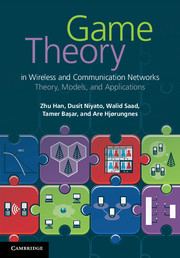Book contents
- Frontmatter
- Contents
- Preface
- 1 Introduction
- 2 Wireless networks: an introduction
- Part I Fundamentals of game theory
- Part II Applications of game theory in communications and networking
- 9 Cellular and broadband wireless access networks
- 10 Wireless local area networks
- 11 Multi-hop networks
- 12 Cooperative-transmission networks
- 13 Cognitive-radio networks
- 14 Internet networks
- References
- Index
9 - Cellular and broadband wireless access networks
from Part II - Applications of game theory in communications and networking
Published online by Cambridge University Press: 25 October 2011
- Frontmatter
- Contents
- Preface
- 1 Introduction
- 2 Wireless networks: an introduction
- Part I Fundamentals of game theory
- Part II Applications of game theory in communications and networking
- 9 Cellular and broadband wireless access networks
- 10 Wireless local area networks
- 11 Multi-hop networks
- 12 Cooperative-transmission networks
- 13 Cognitive-radio networks
- 14 Internet networks
- References
- Index
Summary
In the past two decades, cellular communication has witnessed a significant growth. Today, millions of mobile users utilize cellular phones worldwide. In essence, a cellular network is designed to provide a large number of users with access to wireless services over a large area. The basic architecture of a cellular network relies on dividing a large area (e.g., a city) into smaller areas, commonly referred to as cells. Each cell typically represents the coverage area of a single base station that is often located at the center of the cell. By dividing the network into cells, one can ensure a reliable coverage and access to wireless services. Despite the emergence of ad hoc networks with no infrastructure, the cellular architecture remains prevalent in the majority of existing or soon-to-be deployed wireless networks, because of its proven success. In fact, cellular communication has been the pillar architecture in key wireless systems, from traditional 2G systems such as GSM to 3G systems such as UMTS, and the emerging 4G and 5G systems. Beyond traditional macrocell-based networks (e.g., 3G and 4G networks), the use of small cells, covered by low-cost, low-power stations known as femtocell access points that can be overlaid with existing architectures, has recently become of central importance in the design of next-generation wireless networks. Thus, cellular technology is expected to remain as one of the most important paradigms in future wireless communication systems. In Chapter 2, we provided a comprehensive introduction to cellular communication, its key challenges, as well as its past and projected future evolution.
- Type
- Chapter
- Information
- Game Theory in Wireless and Communication NetworksTheory, Models, and Applications, pp. 255 - 320Publisher: Cambridge University PressPrint publication year: 2011



